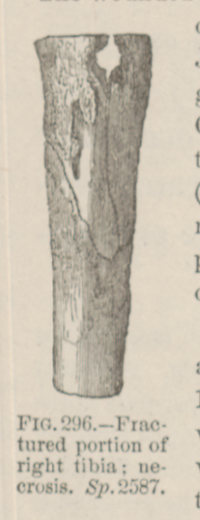Title: Rutter, A.
Source text: The Medical and Surgical History of the War of the Rebellion. (1861-65.), Part 3, Volume 2 (Washington, DC: Government Printing Office, 1883), 514.
Civil War Washington ID: med.d2e19683
TEI/XML: med.d2e19683.xml
CASE 757.—Private A. Rutter, Co. C, 100th Pennsylvania, aged 20 years, was wounded, at Bethesda Church, June 2,1864. Surgeon M. K. Hogan, U. S. V., reported his admission to the field hospital of the 1st division, Ninth Corps, with "shot fracture of right leg by minié ball." Surgeon G. L. Pancoast, U. S. V., who amputated the limb, made the following report: "The wounded man was admitted to Finley Hospital, Washington, on June 15th, from the field hospital. His injury consisted of a compound comminuted fracture of the right tibia, for which amputation was performed at the upper third on June 20th. The operation was done by the flap method and chloroform was used as the anæsthetic, the patient's general condition being excellent. After two days of suffering the patient's progress of recovery was rapid. Cold-water dressings were applied." A part of the amputated tibia (Spec. 2587), showing fracture in the upper third and exhibiting well-marked necrosis, was contributed by the operator and is represented in the wood-cut (FIG. 296). The patient was subsequently transferred to Judiciary Square Hospital, where, after being furnished with an artificial limb by Jewett Patent Leg Co., he was discharged from service May 4, 1865, and pensioned. His pension was paid June 4, 1880. In his applications for commutation he reported the condition of the stump as continuing "all right."
